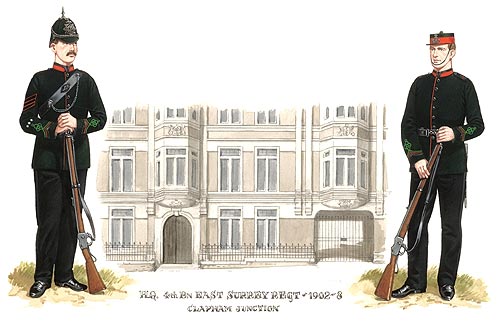23rd Bn The London Regiment
As with the Queen’s, a London Regiment became linked to the East Surreys. The 23rd London Regiment, like most other Volunteer Units had its origins in the Rifle Volunteers raised in 1859 to counter the threat of invasion by Napoleon III and his French forces across the Channel. The 7th Surrey Rifle Corps, raised in Southwark, was affiliated to the 31st and 70th Foot (later The East Surrey Regiment) in the 1870s and in 1880 it absorbed the 26th Surrey Rifle Corps at Battersea.
In 1887 the 7th Surrey Rifles became the 4th Volunteer Battalion The East Surrey Regiment, changing their uniforms from green to scarlet, and so titled furnished 13 officers and 235 other ranks for overseas service during the South African War.

Sergeant, 7th Surrey Rifle Volunteers 1883 and a Private soldier of the same corps.
The building depicted in the centre, St John's Hill, Battersea,
still in use today as Battalion Headquarters, The London
Regiment.
In 1908, with the formation of the Territorial Force, the Battalion became the 23rd (County of London) Bn The London Regiment, losing for a time its connection with The East Surrey Regiment but regaining it in 1916 when the battalion was made part of the Corps of The East Surrey Regiment but still retaining its London title. Colours were presented to the Battalion by King Edward VII at Windsor on 19th June 1909.
Two battalions of the 23rd were found during the First World War for overseas service with a reserve battalion at home. The 1/23rd fought in France and Flanders from March 1915 until the end of hostilities in 1918, being involved in actions at Festubert, Loos, the Somme in 1916 and 1918, Messines, Ypres, Cambrai, Lille and Tournai.
Casualties were heavy, 237 being killed and 262 wounded at Givenchy during the Battle of Festubert. The 2/23rd went initially to France in June 1916 but later went to Salonika and then to Egypt to take part in General Allenby’s offensive against the Turks in Palestine. Finally they returned to France in 1918 and saw action around Ypres.
Twenty-four Battle Honours were awarded to the 23rd, ten of them being carried on the King’s Colour.
Between the wars both battalions were disbanded but the original battalion was reformed in 1920 as part of the renamed and reorganised Territorial Army. In 1923 it was renamed 23rd London Regiment (The East Surrey Regiment).
The usual inter-war training of weekly drills and annual camps took place. Still in the horse-drawn era, the Regiment was preceded on occasions on the march by the Band and Drums with the Commanding Officer, Adjutant and Company Commanders mounted on their chargers. Social activities and sport were also part of the Regimental programme. Excelling at Tug-of-War they were for many years winners of the London Territorial Championship.
 |
| First opening of the Colours since 1939, Crowborough 1947. CSM Williams, Maj G L A Squire MC, C/Sgt Andrews. (Click to enlarge) |
In periods of great change in the 1930s the 23rd were disbanded, eventually to re-emerge in armoured form as the 42nd Royal Tank Regiment. On the outbreak of the Second World War they trained in England until the Spring of 1941 when they went to the Middle East to fight with the Eighth Army and later the First Army on both the Desert and Italian fronts. Some of the key actions in which they took part were Knightsbridge, Medjez Plain, the final advance on Tunis, the crossing of the Lamone at Faenza and finally the passage through the Argenta Gap and across the Po to the outskirts of Venice.
After the war the 42nd Royal Tank Regiment reformed at Clapham but in 1956, with a reduction in armoured requirements, it reverted to its infantry role and resumed its old title of 23rd London Regiment and became once more a battalion of The East Surrey Regiment. Lieutenant Colonel B A Hannaford of The East Surrey Regiment was appointed Commanding Officer, being succeeded in October 1958 by Lieutenant Colonel W H A Robinson TD who was to be the last to hold the appointment before the Regimental amalgamations of 1959 and later. On 1st May 1961, The 23rd London Regiment was amalgamated with the 6th Bn The East Surrey Regiment to form the 4th Bn The Queen’s Royal Surrey Regiment. The name was gone but honourable, distinguished and distinctive memories remained.
Gallery
(Click images to enlarge)
Related







